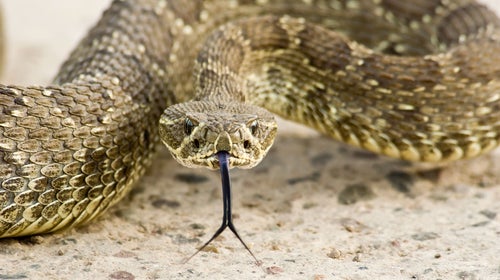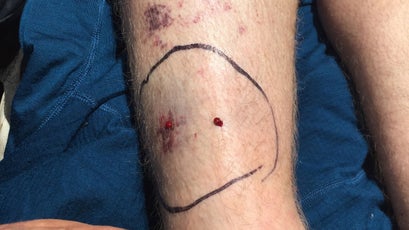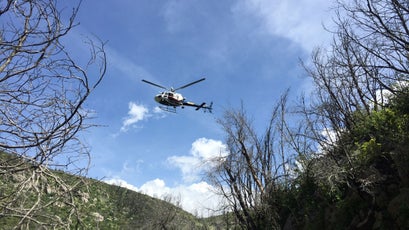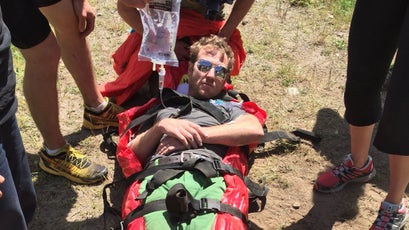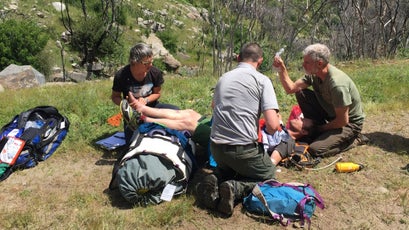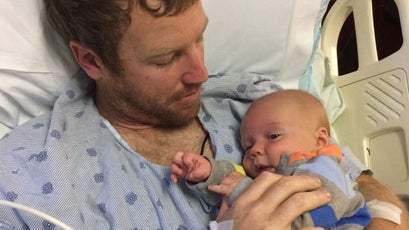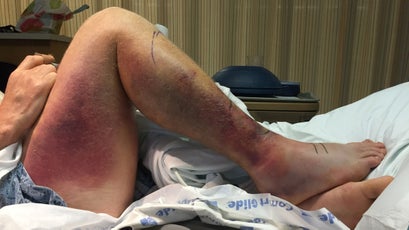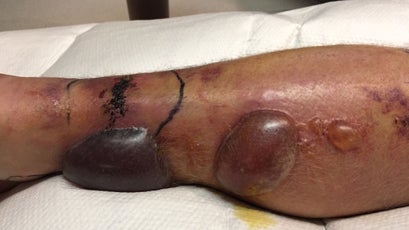A Rattle with Death in Yosemite
When Kyle Dickman set out on a month-long road trip with his wife and infant son last spring, he was fueled by a carefree sense of adventure that had defined his entire life. Then he got bit by a venomous snake in a remote area of Yosemite National Park, and the harrowing event changed everything.
New perk: Easily find new routes and hidden gems, upcoming running events, and more near you. Your weekly Local Running Newsletter has everything you need to lace up! .
My parents like to say they raised my older brother, Garrett, and me in the Church of Seventh Day Recreationalists.
As a kid growing up in Oregon, I remember asking them if we could actually stay home one weekend instead of camping or hiking or canoeing. They relented, but that was the exception to the rule. Through that prism, you might say I was preordained to be with my family on that bridge, with that snake, on that warm April morning in Yosemite. Through another, you might say I was overdue.
Our son, Bridger, was two weeks old when my wife, Turin, and I decided to take the road trip. We were lying with him on the swing in his room, beneath a giant tree frog Turin had painted on the wall. She had three months off for maternity leave. My job was flexible. We wouldn’t have another chance to take a long vacation until we didn’t know when. Two weeks later, we bought a 1988 Ford TransVan, a converted RV that we dubbed Queen, and left our home in Los Alamos, New Mexico, around Bridger’s five-week birthday.
Turin and I had been married for seven years. I was 33. Before I became a writer, I was a wildland firefighter and filmmaker who traveled the world making adventure TV for National Geographic. I’d stepped on a fer-de-lance snake in Belize, been held up by guerrillas with AK-47’s in the Democratic Republic of the Congo, and dodged a snapping crocodile in Papua New Guinea. Somehow loose bowels had been my worst affliction. What guided my decisions was the belief that most things work out and the fear that they won’t is largely exaggerated.
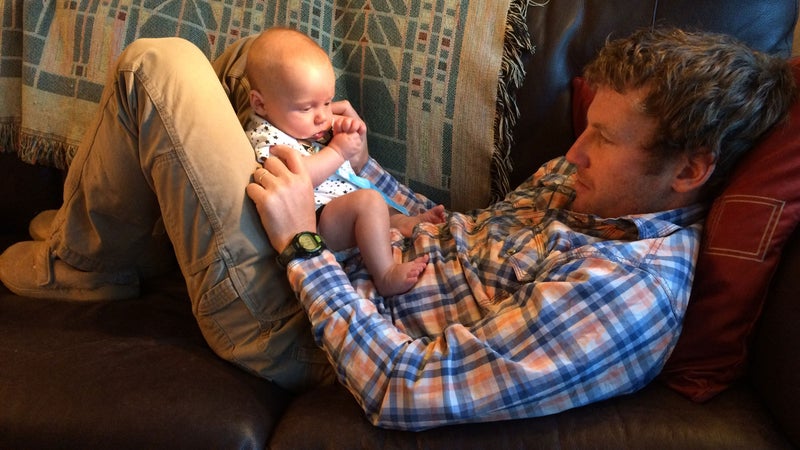
Turin’s lust for adventure matched mine. Since our wedding, she’s taken 14 international trips, in some cases for her job, studying climate change at Los Alamos National Laboratory, but mostly for fun. Fun for her is rafting 145 miles through the Alaskan wilderness, which she did during her first trimester.
Every website Turin and I consulted about preparing for a newborn said “babies thrive on routine.” Routine wasn’t our plan. On our road trip, we shivered in Canyonlands National Park, went canyoneering in Utah’s San Rafael Swell, and surfed waves on the Oregon coast. Bridger was easygoing when we were outside—he was either curious or asleep. He wasn’t smiling yet, but we have photos of him in the West’s most spectacular places looking, as we interpreted his expressions, happy. We have no photos of Bridger crying at 12, 2, 4, or 6 a.m. In fact, Turin and I were exhausted. In the days before we reached Yosemite, the last stop on our monthlong trip, Bridger grew colicky.
My family was awaiting our arrival. For seven years, Garrett, 36, has lived in El Portal, a National Park Service company town near Yosemite’s southwest entrance. He manages the park’s vegetation—all 748,436 acres—and keeps its forests looking like they did when John Muir wandered the hills. But what he really loves is climbing. So does his wife, Erin, also a botanist. They recently bought the 1908 railroad depot in El Portal, with a basement filled with ancient cat shit, because it’s ten minutes from perfect rock.
My recently retired parents, who’d moved into their RV three years earlier, had been in El Portal helping rebuild the depot since January. We spent the night we arrived in their trailer, passing Bridger and glasses of wine around and telling stories. The next morning broke warm enough to wear shorts, and Garrett suggested a walk in the wildflowers above town. “They’re peaking,” he said.
We climbed for three miles from El Portal, through meadows and granite blocks toward 50-foot Foresta Falls, a cascading drop just beneath the community of Foresta. It felt like hiking through a Renoir. Garrett and Erin named off blooms of all colors, and we snapped pictures of the valley and flooded waterfalls. At 11:45, we reached a bridge that crossed a sliding waterfall, and Bridger chirped his need for milk. Turin stopped to nurse him on a granite outcropping.
Snacks were passed around. My parents grazed. Erin lay on the bridge’s downstream rail and napped. She was the only one besides me who saw the snake. “Brown and big” is how she remembers it. I recall seeing a dust-red coil in new grass, but to me the snake was more of a sensation: a light tap just above the sock on my right ankle. Then I passed out.
When I awoke, and after I’d finished my first bout of violent vomiting, I heard my parents already talking through the options to get me out. My mom had been an emergency-room nurse and a physician’s assistant for 35 years. But on the 700 missions she and my dad had conducted as volunteers for the Bend, Oregon, search and rescue team, neither had ever dealt with a rattlesnake bite.
Lying on my back in the grass, I thought maybe that was all the venom would do—make me sick. Or maybe I was dying. I didn’t know it then, but in the medical community, the rule about rattlesnake bites is “.” How many minutes or hours elapse before you get the antivenom, usually in a hospital, determines your fate: an afternoon in the ER, amputation, or perhaps, in my case, death on a stone bridge.
I threw up every few minutes, in intensifying waves. “I’ve never seen anybody that sick,” Garrett would later tell me. He was already running back toward El Portal to get cell service and call dispatch. On a map, Crane Creek Road, where I was bitten, looks drivable. It isn’t. Two wildfires had recently burned the area, and it’d be generous to call what was left a two-track. The dispatcher didn’t know this. She ordered a Life Flight helicopter, standard procedure for rattlesnake bites, and an ambulance stationed in Yosemite Valley, then asked Garrett to run to Foresta to guide the incoming paramedics.
I recall seeing a dust-red coil in new grass, but to me the rattlesnake was more of a sensation: a light tap just above the sock on my right ankle. Then I passed out.
By then, rivulets of blood, thinned by the venom, ran from the puncture wounds. My leg burned from snake proteins that had evolved to cause pain. I was in shock and lying beside a large puddle of vomit, the by-product of toxins. I felt like I had after eating bad fish in Laos—except I was terrified. Turin had nursed me through that sickness with Cipro and orange soda, and I asked her to marry me on a pirogue on the Mekong four days later.
Turin couldn’t help me through this one, though she tried. “Bee sting?” she initially asked, trying to figure out what was going on. She started shaking soon after hearing my one-word reply. For a time she rubbed my back in consoling circles between bouts of vomiting.
“Get Bridger out of here,” I told Turin. My request hurt her. But I couldn’t stand the thought of her or our son watching me die. So she carried him back down the road, watching from a distance while I gripped my parents’ hands.
In late September, six months after my bite, I visit Southern California’s Loma Linda University, one of the country’s leading treatment centers for snakebite victims. I’m there to meet Bill Hayes, a biology professor who has studied rattlesnakes since he was 18 and smuggled cottonmouths into his parents’ car on family road trips. He’s 56 now, and has spent several decades researching everything from the distance pit vipers travel from their winter dens (up to 15 miles) to how the volume of venom a large snake injects is affected by denim (it drops by 60 percent). Hayes’s current focus is the varying severity of snakebites. With the help of graduate students, Hayes has culled the medical records of 166 victims treated at Loma Linda over the past decade. What they found: . “What it really boils down to,” he says, “is how much venom the snake injects.”
Like many conclusions in science, his rest on piles of dead mice. To determine how much venom little snakes use compared with big ones, Hayes released genetically similar male mice into a small arena containing hungry snakes that ranged from nine inches long to four feet. After each mouse was bitten, Hayes stole the snake’s meal, tossed it in a blender, and used a combination of antibodies and dye to isolate the venom from the mush. “Kinda gross,” he says. Hayes found that, contrary to a persistent myth, adult snakes are far more lethal to humans than baby ones. The reason is intuitive: they’re bigger and produce more venom. Hayes found that four-foot snakes injected close to 100 milligrams into the mice. The nine-inch snakes injected less than five milligrams—only a couple of drops.
“So how much do you think the snake injected into me?” I ask, arriving at the point of my visit.
“That’s tough,” he says. For one thing, his research suggests that snakes tend to put more venom into predators than prey. He asks me to ballpark the length of my rattlesnake. The only metric I have is the distance between the fang wounds on my ankle—about an inch and a quarter. He pulls up a chart on his laptop that displays snake sizes and venom yields and spends a few minutes clicking. “Baw,” Hayes says, giving up. “Math isn’t so fun.” (In a couple of weeks, he’ll e-mail me his best guess. “Certainly a big snake at 46 inches.” That would make it as thick as my forearm.)
For a more practical demonstration, Hayes leads me to the hallway. He wants to show me how he figured out how much venom snakes use in defensive strikes. “Gerad’s coming out with a western diamondback,” he tells me. Gerad is a graduate student and Hayes’s snake tender. Hayes disappears into the snake room and returns holding a three-foot-long pole with a saline-filled orange glove taped to a hook at the end.
“Do you want the honors?” Hayes asks.
I say sure, not yet realizing that the goal is to get the diamondback to strike the pretend hand. When Gerad walks out holding a three-foot snake, Hayes hands me the pole, but my confidence cracks. “I don’t know that I do want the honors,” I say.
“No, no, no, you’re fine,” Hayes tells me. Then he sees my face. “You want me to do it?”
Gerad sets the snake on the tile floor. Hayes reminds me that we are in a hospital that counts among its employees the best snakebite physicians in the country. Then he offers to shoot a video with my phone. I hear myself agreeing to hold the stick.
The snake coils into a defensive position and strikes at Gerad’s own stick. “W�Ǵ�-�Ǵ�!” he says. “This one’s a live wire.” He should know. He spent nine days in the hospital two years ago after a snake bit him during this same test.
“Ugh,” I grunt. “This is totally making me very uncomfortable.”
“You gotta dangle it,” Hayes says. “Get closer. You’re fine.”
“Get it within six inches of his face.”
There’s six feet between me and the snake, which is now coiled and ready to strike, looking like the Karate Kid prepping for a crane kick. When its had enough of me poking its outer coil, the snake lashes at the glove in a whiplash motion that I’ll watch on my phone hundreds of times over the next few weeks. Its jaws swing open; the fangs, each an inch of needle-sharp, hollow bone, unhinge from the roof of its mouth. The moment the fangs touch the glove, the venom glands plunge like hypodermic needles, shooting poison into saline.
Gerad recaptures the snake. “Good work, buddy,” he coos to the still rattling diamondback. Normally, they’d put the punctured glove over a bucket of water and then isolate the venom, but they’ve already tested this snake and know that it injects around half a milliliter—a quarter-teaspoon. That’s enough to kill more than 2,000 mice. Or a 150-pound new father.
Garrett sprinted toward Foresta until he reached the bridge over Crane Creek. But the creek was flooded, and the bridge was burned out except for four steel girders that were wet from mist and shaking from the thundering water. Downstream, the creek swept off a 150-foot drop. This gave Garrett pause. My brother isn’t reckless. He is calculating, confident, and experienced—all of which had little to do with why he decided to cross one of the girders anyway. Across the valley, he could just make out my parents huddled over me. “You were actively dying,” he told me later. He grabbed the rail with both hands, dropped to his butt, and scooted his way into the downpour.
According to dispatch logs, Garrett ran more than two miles and up 800 feet in 19 minutes. That included the bridge crossing. By then, Jason Montoya, a park ranger in Yosemite who also specializes in technical rescues for the elite (YOSAR), was speeding from the Valley toward me, lights on and sirens blaring. He’d ordered a second helicopter, plus a litter team with six volunteers to hike up from El Portal, should the helicopter fail. Based on the coordinates Garrett gave to dispatch, Montoya figured they’d need to fly me out of the canyon with a hoist-equipped helicopter, then transfer me to a Life Flight with a paramedic on board. Best-case scenario, he thought, I’d be in the emergency room in an hour and a half.
During the busiest times of the year, there’s a hoist-equipped helicopter stationed in Yosemite. But it wasn’t scheduled to arrive for another week. Dispatch tried its usual backup but it was on another call. A second backup was sidelined with an oil leak. Finally, at 1:11, a helicopter took off from Paso Robles, an hour and 45 minutes away. By then April 23 was turning into an unusually busy day for park search and rescue. Shortly after my bite was reported, other calls poured into dispatch. There was a back injury from a moped fall at Upper Pines Campground, a lost kid at Camp 4, a sheet covered in blood found at Yosemite Falls, and a woman knocked unconscious after stumbling at the top of Vernal Falls—all of which fell under YOSAR’s jurisdiction.
Just below Foresta, Garrett crossed back over Crane Creek on an intact bridge and met the ambulance. A fallen tree had blocked its path and one wheel was stuck in the road’s soft shoulder. Three medics were scrambling to pull gear from the truck: IVs, an inflatable backboard, drugs, and medical supplies. Garrett recognized one of them immediately. The year before, he’d met Levi Yardley, a 34-year-old paramedic from Savannah, Georgia, on a climb that required crossing from a detached pinnacle while dangling 2,000 feet above the Valley. Yardley threw him a bag of medical equipment, and Garrett, Montoya, Yardley, and one other medic took off down the road. When they reached the burned-out bridge Garrett had scooted across 20 minutes earlier, YOSAR’s medics turned around. “If someone slips, they’ll be dead,” Montoya remembers thinking. “We couldn’t take that risk.” So they ran more than a mile back up the hill they’d just descended and crossed Crane Creek on the upper bridge. Then they bushwhacked toward me across cliff bands and through waist-high poison oak.
They did all this within an hour of my snakebite. It was 12:51 when they arrived. The scene took Yardley by surprise. My pants were half off. For the past hour, my mom and dad had been rolling me from my back to my side to vomit or shit. Diarrhea had started about 20 minutes after the bite, and my dad made a joke about not having wiped my ass since I was Bridger’s age. The dirt around me had long since soaked up the liquid that had been in my body. I was pale and sweating, moaning in pain. My blood, unable to clot, wept from the puncture wounds on my ankle, and bruising, a sign of internal hemorrhaging, had bloomed to above my knee.
Around the time Yardley and Garrett arrived, my mom noticed patches of blood in my bile but didn’t mention it. “Why scare anybody worse?” she said later.
Among American snake enthusiasts, Stephen Mackessy is known as a venom guru. The rest of us would call him a biochemist. In mid-October, seven months after the bite, I got an e-mail from his office at the University of Northern Colorado. Someone had sent him a venom sample from a snake found 50 miles or so south of Foresta, and he thought it could be useful in explaining my symptoms. He also mentioned that, two weeks earlier, a 31-year-old had been bitten on the ankle by a rattlesnake near Golden, Colorado. The victim “coded before he got to the hospital,” as Mackessy put it.
“May have hit the saphenous vein, which would be sort of a direct line to the heart—a random and tragic event,” he wrote. He thought my snake had also hit a vein, albeit a smaller one on the outside of my ankle that’s about an inch from the saphenous.
Mackessy is 62, with a gray beard, gray hair, and the quiet thoughtfulness of a man who views the world through a microscope. A few weeks earlier, I’d visited his office in Greeley to see if he could explain the extreme variety of my symptoms. We didn’t explore the question until late that evening, after Mackessy showed me the lab where he pulls venoms apart using molecular weight or polarity. Most predators kill or injure mechanically—like a paw swipe to the temple. Rattlesnakes work chemically. Their venom is biomimicry at a molecular level.
A quick refresher on the foundations of life: Grouped atoms make molecules. Grouped molecules make proteins. Grouped proteins make cells. And cells, in networks of billions, make every living thing on earth. When proteins click together just perfectly, chemical reactions occur that prompt all kinds of human functions, from sweating to smiling.
Snake venom contains a suite of proteins that dock perfectly with the cells and proteins humans use to regulate our respiratory, vascular, and digestive systems. Except that when the venom proteins dock, it’s sabotage. “Mammals operate within very narrow parameters,” Mackessy explains. “We don’t tolerate big swings to our heart rate, -temperature, or blood pressure. Venom is like a shotgun blast to the intricate inner workings of a watch.”
Mackessy calls venom’s ability to affect so many different life functions a product of “evolutionary warfare.” He points to a dead fence lizard stuffed into a vial in his lab. This species of lizard, which came from a sky-island mountain range in Arizona, has developed resistance to the venom of the rattlesnakes that prey on it; however, over time and through evolution, the rattlesnakes are also adapting, developing proteins to sidestep the lizard’s defenses. This one-upmanship between predator and prey explains why venoms, and the actual mechanism they use to kill or harm, vary not only between species of rattlesnakes but also within populations of the same species. One example of this hyperspecialization can be seen in the southern Pacific rattlesnake, which claims the bottom half of California as its territory. One researcher recently discovered that a bite from a Pacific rattlesnake near sea level in San Bernadino County prevents a victim’s blood from clotting. But get bitten by the same species in the mountains of the same county and your blood will clot.
Snakes brew their venom in glands located behind the eyes. In a snake’s lifetime, these glands can weaponize—or attempt to weaponize—many proteins that have alternative functions in its own body. One that digests food may be tweaked to break down living prey. Or a protein that increases the snake’s blood pressure could be altered to decrease that of its meal. For a sense of just how sophisticated and varied venom is, consider that all 300 of the world’s venomous snake species have been fine-tuning their toxins for millennia. In the venom of the rattlesnake species that bit me, a northern Pacific, more than 75 proteins have been identified—and Mackessy thinks many more may yet be discovered.
We’re now in his office, where mason jars filled with rattlesnakes coiled in alcohol line the shelves. Mackessy says he’s hesitant to describe what any one venom protein did to my body, because it’s like describing the role a single note plays in a sonata. It tells an incomplete story. Proteins work in concert.
Caveats aside, Mackessy starts with my first symptom: fainting. The body regulates blood pressure through proteins that cause veins and arteries to expand or contract. Northern Pacific rattlesnake venom contains a protein that functions identically. Within moments of getting struck, Mackessy explains, the venom “rapidly and inappropriately” relaxed the vessels that regulate blood flow. “Blood pressure went like this,” Mackessy says, whistling and sliding his hand down an imaginary slope.
My body tried to correct this by flooding my vasculature with a protein that constricts blood vessels. And here’s where venom gets particularly nasty. The same venom protein that caused my blood pressure to drop also destroyed my body’s tools for increasing it. “That’s just one thing—one component in one venom,” Mackessy says.
While I was passed out, he goes on, an enzyme called metalloproteinase broke down my leg veins’ walls until I began to hemorrhage internally. Meanwhile another venom protein, disintegrin, acted as a magnet to my platelets and fibrinogen, molecular components that help blood clot. As my body sent them racing to plug the puncture wounds, the snake protein destroyed them, like a host who throws a house party and clubs guests the moment they arrive. Welcome!
Mackessy describes a toxin that made my smooth muscles—those in my digestive tract—convulse, pushing my stomach’s contents out both ends. Another liquefied the cellular architecture in my leg, releasing fluid that led to elephantine swelling while simultaneously quickening the venom’s spread upward by turning flesh, as he describes it, into “diluted Jell-O.” Still another digested my muscle tissue. He shows me a picture of an untreated snakebite case taken nine days after the strike. The victim’s foot is a mess of exposed bones.
In my case, all these processes happened almost instantaneously because the rattlesnake’s fang hit a vein.
After assessing the scene, Yardley rip-ped open his medical kit. During the summer, Yosemite keeps a small supply of anti-venom on hand for cases like mine, but those vials had been used the previous year and hadn’t yet been restocked. Instead, he tossed my mom a blood-pressure cuff and grabbed 2,000 milliliters of saline, a pill to stop the vomiting, and fentanyl, a powerful painkiller. My mom, the ranking medical professional on the scene, drew the drugs into syringes, and as Yardley worked he asked her to start an IV. She paused. “I don’t feel comfortable doing that,” she said. “I’m a PA, but I’m a mom first.”
Yardley took over, sticking a 16-gauge needle—a medical railroad spike—into each of my arms. The drugs worked. I hurt less and stopped purging. And the IV rehydrated me temporarily. Then Montoya showed up, and a little later, the litter team from El Portal loaded me onto the inflatable backboard. I mustered a smile when they put aviator sunglasses on me to protect my eyes, anticipating that the helicopter was about to arrive. We even made time to snap a family photo, with Turin, Bridger on her chest, giving a thumbs-up and me looking like smiling death.
At 2:07, the litter team carried me to the helicopter pickup point. “That’s when things started to unravel,” Montoya says. He’d discovered that he couldn’t transmit radio calls from the canyon.
Ten minutes later, yet another emergency page went out—the 19th of the day—further occupying resources. Since my bite and the other slate of mishaps that morning, a woman had suffered a heart attack and broken her ankle on the Mist Trail, bears were pestering tourists on the Southside Trail, and a man in his twenties had had a seizure in Half Dome Village. Now there was a garage fire in El Portal. From where he stood, Garrett could see black smoke rising across the street from his house. Between us and the flames was a grass field that three years earlier had torched in half an hour. The helicopter was still 20 minutes away.
“If we don’t get him out of here now, we’re going to have a critical patient on our hands, and I don’t have the meds to deal with him,” Yardley told Montoya, who was overseeing the incident. It had now been more than an hour. The drugs had run their course, and my symptoms had returned. Then, while the seven first responders stood around me, a bee stung my thigh. “Fuck!” I said. “I’m allergic.”
Yardley told somebody to get an EpiPen.
“Please don’t,” I pleaded. I was worried that the epinephrine would agitate the snake venom. About then the helicopter finally appeared over the ridge, and Yardley gambled that if I hadn’t gone into anaphylaxis yet, I wouldn’t.
It was 4:30 p.m. The brush beat about in the downdraft, and a cable was lowered. I felt myself tugged from the ground, and a surge of relief.
As the thumping of the helicopter faded, Turin gave in to the dark thoughts she’d been ignoring for the past three hours. “Compartmentalizing,” as she calls it. She and my parents broke into sobs. Bridger didn’t make a sound. He hadn’t—not a single colicky cry—since the bite.
Bill Hayes keeps a collection of snakebite kits in a display case outside his Loma Linda office. There are dozens. Some contain razors to cut the wound, to milk the venom out. Others have pumps to suck a bite dry, or sulfide to sterilize it. That day in Yosemite, we didn’t have one of these kits, which is probably just as well. None of them work. Nor do any of the folk treatments people still try today, which call for everything from freezing the wound to slathering it with motor oil, silver nitrate, or a poultice made from the snake’s crushed head. “Antivenom—that’s the only cure,” Hayes told me.
Today’s antivenom isn’t so different from the stuff developed in the 1890s by French scientist Albert Calmette. After a flood pushed water-averse cobras into the Vietnamese village where he was studying, 40 people were bitten, and four died. Calmette, who was a protégé of Louis Pasteur, applied the same techniques his mentor was using to produce vaccines for rabies and anthrax. He milked cobras and injected tiny amounts of venom into horses. After a few weeks, Calmette extracted the horse blood and spun out antibodies that targeted cobra venom.
Snakebites were more lethal back then, but the World Health Organization still considers them a global health crisis. Each year snakes kill more than 81,000 people and maim hundreds of thousands more. Modern antivenom is still made in livestock, and while it has gotten more effective over time, it is mostly species-specific. In the U.S., it’s also outrageously expensive. A single vial can cost $18,000, which goes a long way toward explaining why many physicians refer to the supply of antivenom in this country as a “drug drought.” Many clinics and hospitals don’t stock it, and it’s rarely carried by search and rescue teams.
After the helicopter touched down at Doctors Medical Center of Modesto, nurses wheeled me into the emergency room and cut off my shorts and T-shirt. Five and a half hours after my bite, they hooked me up to my first IV laced with antivenom. Over the next 72 hours, I’d receive 18 vials.
Each of the half-dozen doctors I saw told me this was either the first snakebite they’d ever seen or the worst. Poison Control, which the nurses called every two hours, guided my care. My leg, from toe to hip, turned black and yellow and eventually swelled to 24 inches, more than twice its normal circumference. My blood chemistry mimicked a pattern the nurses compared to that of drug-overdose patients. During my first day in the hospital, I received morphine every two hours, yet the pain remained too severe to sleep. It felt as though nerves were popping in my leg.
The orthopedic surgeon grew convinced that I had developed compartment syndrome, a side effect of swelling that cuts off circulation to extremities and in the worst cases leads to amputation. Fixing it requires an only slightly less intrusive emergency surgery—deep incisions along the length of my leg to relieve the pressure. My night nurse, John, was a 71-year-old Vietnam vet who’d been struck twice by rattlesnakes and recommended I do as he’d done and eat the snake that had bitten me. (“More gamy than fishy,” he said.) It was John who saved me from going under the knife. In the early morning, he found a pulse at the top of my foot, a sign that I still had circulation—enough to keep the surgeons from operating.
It took four more days for me to move from a bed to a chair. Two more to stand up. And eight before the doctors released me. By then my platelets had finally stabilized at a level high enough to rule out spontaneous bleeding. In the end, the total bill for the final stop of our monthlong road trip to introduce Bridger to the West was $450,000. I guess our monthly health care premiums paid off.
“It’s lousy with prey,” Garrett whispers as a lizard skulks across the road. It’s September in Yosemite, and we’re on our way to revisit the bridge where I was bitten. This time we’re joined by two herpetologists: Robert Hansen, who edits the journal , and Rob Grasso, Yosemite’s resident park ecologist. The pair, dressed in safari gear, are flipping over rocks and logs with a rake. Meanwhile, Garrett and I strap on Kevlar chaps, as though we’re preparing to disarm a car bomb.
Hansen rolls his eyes when he sees us. “They don’t want to bite you,” he says, then wades deeper into the oak trees, where he thinks he’s heard the high-pitched zzzt of a baby snake’s rattle.
We’re here because the snakebite did more than scar my ankle and leave me with a searing curiosity about venom. I felt fine physically but was consumed with an unfamiliar sense of vulnerability. I’ve returned to the bridge in search of some kind of closure. To be snakebit also means to experience a period of bad luck, which is what I’ve lived through since the ordeal. Shortly afterward, our dog Mud got hit by a car. He survived, but weeks later we had to put down our other dog, 13-year-old Lucy. A friend sustained a severe concussion while we were biking. Another broke his neck skiing. Yet another lost his dad to a stroke. Then there were the many news events of 2017 that don’t need rehashing. Plenty of good happened, too. That I lived comes to mind. Waking up to Bridger every day. My parents bought a house near our home in Los Alamos to be closer to us.
But the good was obscured. I felt broken. Fear was no longer thrilling—just scary and everywhere. At night I’d grab Turin in my sleep because, I insisted, she was falling and I needed to catch her. I struggled to walk in the woods without seeing something slither.
“Maybe you just see the world like the rest of us always have,” one friend suggested. Maybe, but I missed my old optimism. Instead I felt sad, grateful, dazed. Turin went back to work, and watching Bridger fell to me. After putting him to bed, I’d disappear into my phone and a bottle of wine. Tears came often and too easily. “Is everything OK?” Turin asked me one morning. It wasn’t, and she knew it. I was a ghost.
Around that time, some close friends came over for dinner. They have two sons—one three and the other one and a half. We loaded our boys into Queen and pretended she was a fire truck. We drove through the neighborhood, hosing down fake flames licking at the steps of houses. At one point we spotted a herd of deer, their coats thickening for winter. Our friends’ oldest son, Max, and I snuck out of Queen and crawled through dead, dry grass until we lay within 20 feet of a family. “They’re in a herd because being together is how they survive the coming winter,” I told him in a whisper. “That’s the mom there, and those are her babies.”
“Where’s the dad?” Max asked. He repeated the question a few more times, because I didn’t have the answer. I wasn’t sure what bothered Max about the sight of an incomplete family, or if that was it at all. But I did know that three days earlier, his mom had been diagnosed with breast cancer.
Fear was no longer thrilling—just scary and everywhere. I’d grab Turin in my sleep because, I insisted, she was falling and I needed to catch her.
Probably like her, I wanted to know if I’d done something wrong to deserve my fate. Maybe I violated some rule of nature unknown to me. Maybe the bridge would reveal answers only the herpetologists can interpret. Rattlesnakes, Hansen tells me, emerge in spring hungry, spend their summers hunting, and head back to the same den in the fall to breed. Hansen and Grasso suspect that I was bitten after stumbling onto a den during spring emergence. Finding snakes here might confirm their suspicion.
Finally we reach the bridge, the exact spot where I was struck. I’d always thought of rattlesnakes as the gentleman’s viper—considerate enough to warn you before they bite. Mine never rattled. I ask Grasso why, and he’s not sure.
“I mean, I have to harass the shit out of them to get them to coil in strike position,” he says. He’s now at creek level, craning his head into a fissure in the granite on the bank which might be a den. “I don’t think it could feel your vibrations,” he says. Because the creek had been flooded at the time, he posits, the snake’s senses might have been overwhelmed by tremors of rushing water shaking the bridge. It was probably hunting and unaware of me until I stepped into its field of vision and boom! “I’m surprised you lived,” he says. Which I hear as “You’re lucky to be here,” and suddenly it feels nice to be lucky.
“You guys want to eat something?” I ask. We all sit on the bridge where I almost died and eat mushy Red Delicious apples. I suppose I should feel reverent about this spot, but I don’t. It’s just another beautiful place where a bad thing happened.
“That ledge there, that’s my best guess,” Hansen says, pointing to a shadowy overhang located about 30 feet up a slab of sloping granite, where he imagines the den might be. Neither he nor Grasso feel comfortable climbing up to it.
Garrett turns to me. “Want to check?”
“Yeah,” I say, trying to sound bold. “Fuck these snakes.” When we reach the ledge, I peer into a dark crack and see a mouse skitter across the base of the opening, but no snakes. Hansen’s right—rattlesnakes don’t want to bite people. They don’t even want to be seen. Sometimes we just step on a piece of bad luck. And then get stung by a bee.
Contributing editor Kyle Dickman () is the author of , an account of the Yarnell Hill Fire.

